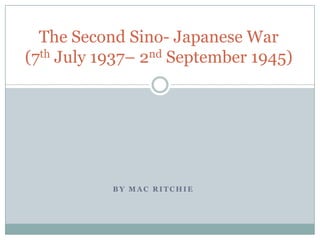
The second world war (china vs japan) final
- 1. The Second Sino- Japanese War (7th July 1937– 2nd September 1945) BY MAC RITCHIE
- 2. Background - China 1930’s China - distracted by civil war Chiang Kai-Shek Mao Tse-Tung Nationalist Government Chinese Communist Party (CCP) Kuomintang (KMT) Various War Lords
- 3. Background- Japan 1930’s Japan - eager for natural resources Japan China Densely populated Sparsely populated Scarce natural Abundant natural resources resources Manchuria Arable Land, Coal, Iron, Soybeans, Salt 1931- Japan invades Manchuria & creates puppet–state “Manchukuo” Condemned by League of Nations, however no military action is taken. The West is distracted by the Great Depression.
- 4. Start of the Second Sino - Japanese War - 1937 The Marco Polo (or Logou) bridge incident sparked the full blown conflict Linked Beijing to KMT controlled areas in southern China In response, KMT & CCP formed an alliance to fight Japanese under the Sian Agreement Growing international anti-Japanese sentiment – Stalin supports CCP & West supports KMT with aid
- 5. The Conflict Escalates through late 1930’s Japanese capture key Chinese ports & industrial centres as well as Nanking & Shanghai Both sides use “Scorched earth tactics” Infrastructure, transportation, communication destroyed and high number of civilian deaths Massacres & atrocities were common In 8 years of conflict, 20 million Chinese were killed
- 6. By 1940, “Stalemate” The Japanese were unable to force a victory over Chinese and Chinese were unable to evict the Japanese from occupied areas By 1941, the Chinese position was precarious 1930’s military aid dries up with war in Europe Alliance between KPT and CCP is fragile
- 7. Anti-Japanese Sentiment Grows in West Japan is building an Asian Empire The US and other Western countries have extensive economic interests throughout Asia In 1941, the US imposed an oil embargo on Japan which led the Japanese to attack Pearl harbour on 7th December 1941, On December 8th 1941, US declared war on Japan. Pearl Harbour
- 8. China Set to Be Greatest Ally for US In February 1942, the US congress loaned China $500 million China to be centre of US military effort against Japan In reality, there were other more urgent battles to be fought in Asia and aid for China plummeted It was also difficult to send support to China over the Himalayan mountains In 1944, from April to December, Japanese launched a major offensive called Ichi-go which put China on the brink of defeat.
- 9. End of the Second Sino-Japanese War Two Events ended the war in 1945 - On 6th August, US dropped atomic bombs on Hiroshima. On 9th August, Stalin declared war on Japan and overran the Japanese army in Manchuria. Then the Japanese forces in China surrendered. The civil war resumed immediately. Japanese soldiers surrender